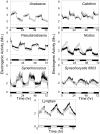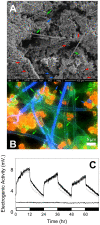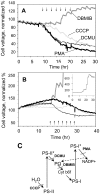Light-dependent electrogenic activity of cyanobacteria
- PMID: 20520829
- PMCID: PMC2876029
- DOI: 10.1371/journal.pone.0010821
Light-dependent electrogenic activity of cyanobacteria
Abstract
Background: Cyanobacteria account for 20-30% of Earth's primary photosynthetic productivity and convert solar energy into biomass-stored chemical energy at the rate of approximately 450 TW [1]. These single-cell microorganisms are resilient predecessors of all higher oxygenic phototrophs and can be found in self-sustaining, nitrogen-fixing communities the world over, from Antarctic glaciers to the Sahara desert [2].
Methodology/principal findings: Here we show that diverse genera of cyanobacteria including biofilm-forming and pelagic strains have a conserved light-dependent electrogenic activity, i.e. the ability to transfer electrons to their surroundings in response to illumination. Naturally-growing biofilm-forming photosynthetic consortia also displayed light-dependent electrogenic activity, demonstrating that this phenomenon is not limited to individual cultures. Treatment with site-specific inhibitors revealed the electrons originate at the photosynthetic electron transfer chain (P-ETC). Moreover, electrogenic activity was observed upon illumination only with blue or red but not green light confirming that P-ETC is the source of electrons. The yield of electrons harvested by extracellular electron acceptor to photons available for photosynthesis ranged from 0.05% to 0.3%, although the efficiency of electron harvesting likely varies depending on terminal electron acceptor.
Conclusions/significance: The current study illustrates that cyanobacterial electrogenic activity is an important microbiological conduit of solar energy into the biosphere. The mechanism responsible for electrogenic activity in cyanobacteria appears to be fundamentally different from the one exploited in previously discovered electrogenic bacteria, such as Geobacter, where electrons are derived from oxidation of organic compounds and transported via a respiratory electron transfer chain (R-ETC) [3], [4]. The electrogenic pathway of cyanobacteria might be exploited to develop light-sensitive devices or future technologies that convert solar energy into limited amounts of electricity in a self-sustainable, CO(2)-free manner.
Conflict of interest statement
Figures







Similar articles
-
Role of the photosynthetic electron transfer chain in electrogenic activity of cyanobacteria.Appl Microbiol Biotechnol. 2011 Jul;91(2):377-85. doi: 10.1007/s00253-011-3239-x. Epub 2011 Apr 12. Appl Microbiol Biotechnol. 2011. PMID: 21484209
-
Photosynthetic Microbial Fuel Cells.Adv Biochem Eng Biotechnol. 2016;158:159-175. doi: 10.1007/10_2016_48. Adv Biochem Eng Biotechnol. 2016. PMID: 28070595 Review.
-
Photosynthetic microbial fuel cells with positive light response.Biotechnol Bioeng. 2009 Dec 1;104(5):939-46. doi: 10.1002/bit.22466. Biotechnol Bioeng. 2009. PMID: 19575441
-
Marine phototrophic consortia transfer electrons to electrodes in response to reductive stress.Photosynth Res. 2016 Mar;127(3):347-54. doi: 10.1007/s11120-015-0193-y. Epub 2015 Sep 25. Photosynth Res. 2016. PMID: 26407568
-
Harnessing photosynthesis to produce electricity using cyanobacteria, green algae, seaweeds and plants.Front Plant Sci. 2022 Jul 27;13:955843. doi: 10.3389/fpls.2022.955843. eCollection 2022. Front Plant Sci. 2022. PMID: 35968083 Free PMC article. Review.
Cited by
-
Metagenomic profiles of free-living archaea, bacteria and small eukaryotes in coastal areas of Sichang island, Thailand.BMC Genomics. 2012;13 Suppl 7(Suppl 7):S29. doi: 10.1186/1471-2164-13-S7-S29. Epub 2012 Dec 13. BMC Genomics. 2012. PMID: 23282134 Free PMC article.
-
A Storable Mediatorless Electrochemical Biosensor for Herbicide Detection.Microorganisms. 2019 Nov 29;7(12):630. doi: 10.3390/microorganisms7120630. Microorganisms. 2019. PMID: 31795453 Free PMC article.
-
Utilizing Cyanobacteria in Biophotovoltaics: An Emerging Field in Bioelectrochemistry.Adv Biochem Eng Biotechnol. 2023;183:281-302. doi: 10.1007/10_2022_212. Adv Biochem Eng Biotechnol. 2023. PMID: 36441187
-
Over-expression of an electron transport protein OmcS provides sufficient NADH for D-lactate production in cyanobacterium.Biotechnol Biofuels. 2021 Apr 29;14(1):109. doi: 10.1186/s13068-021-01956-4. Biotechnol Biofuels. 2021. PMID: 33926521 Free PMC article.
-
Electrochemical investigation of a microbial solar cell reveals a nonphotosynthetic biocathode catalyst.Appl Environ Microbiol. 2013 Jul;79(13):3933-42. doi: 10.1128/AEM.00431-13. Epub 2013 Apr 19. Appl Environ Microbiol. 2013. PMID: 23603672 Free PMC article.
References
-
- Waterbury JB, Watson SW, Guillard RRL, Brand LE. Widespread occurrence of a unicellular, marine, planktonic, cyanobacterium. Nature. 1979;277:293–294.
-
- Whitton BA, Potts M. Dordrecht, London, Boston: Kluwer Academic Publisher; 2000. The Ecology of Cyanobacteria: their Diversity in Time and Space.704
-
- Chaudhuri SK, Lovley DR. Electricity generation by direct oxidation of glucose in mediatorless microbial fuel cells. Nat Biotechnol. 2003;21:1229–1232. - PubMed
-
- Lovley DR. The microbe electric: conversion of organic matter to electricity. Current Opinion in Biotechnology. 2008;19:1–8. - PubMed
-
- Rasmussen B, Fletcher IR, Brocks JJ, Kilburn MR. Reassessing the first appearance of eukaryotes and cyanobacteria. Nature. 2008;23:1101–1104. - PubMed
Publication types
MeSH terms
Substances
LinkOut - more resources
Full Text Sources
Other Literature Sources
Molecular Biology Databases

